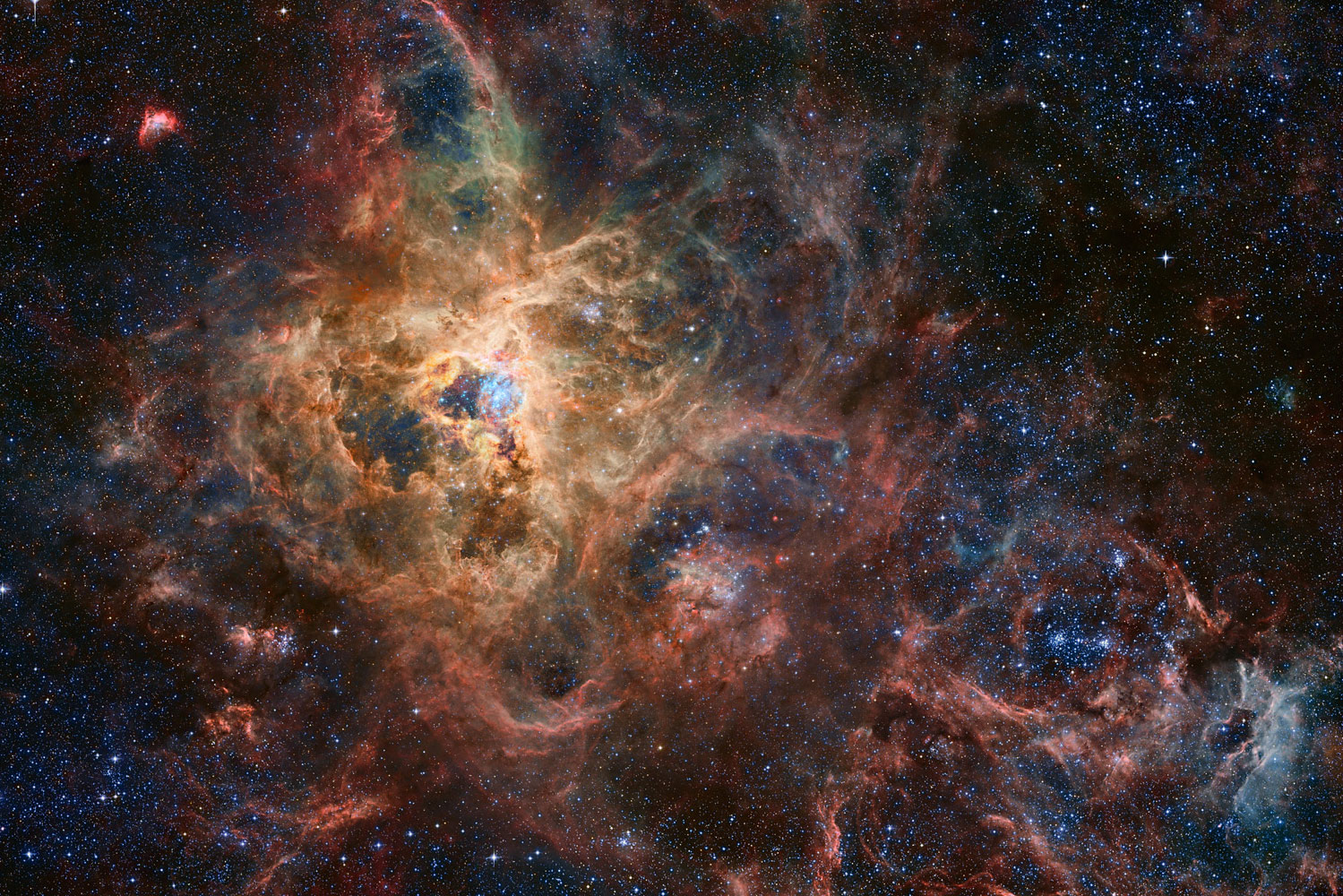I hope you’re sitting down, because my goal here is to reduce your brain to a small pile of gibbering goo.
Luckily, I have help. Behold, the Tarantula Nebula!
Holy WOW. This composite image
by Robert Gendler and Roberto Colombari is incredibly beautiful … and
it’s not even anywhere near full size here. Step one in brain
destruction is to click here for the staggering 6,000 x 4,858 pixel version.
Gendler and Colombari combined data from Hubble and the Widefield Imager
on the 2.2 meter MPG/ESO in Chile, and data Gendler took using a 37 cm
telescope located in Australia to create this phenomenal photograph.
Overall, the combination is very nearly seamless (if you do look hard
enough, you’ll see the edges where different telescope images were
combined; a big hint is that the resolution changes). Hubble has
observed this nebula many times, and the inner structures in the middle
reflect the highest resolution Hubble data. Helpfully, Gendler and
Colombari provide an annotated version as well.
The Tarantula is a gigantic gas cloud located in the Large Magellanic Cloud, a small satellite galaxy to the Milky Way,
and one of the closest galaxies in the Universe to us, roughly 160,000
light-years away. That makes it an ideal target to study—close enough
that we can get an overall picture of its structure, and still get very
highly detailed images of it as well.
The
Tarantula is one of the largest known star-forming nebula for millions
of light-years around us and sitting right there close by for us to
examine. Everything about it is ridiculous. It’s 600
light-years across, vast by any account—the Orion Nebula, a big cloud in
our galaxy, is “only” 25 light-years across. Orion is visible faintly
to the naked eye at a distance of 1,400 light-years; if the Tarantula
were that close, you wouldn’t be able to cover it up with your
outstretched hand, and it would be so bright it would cast shadows!
Where
does it get all this power from? The nebula is churning out high mass
stars, and they blast out energy at soul-crushing rates. Here’s your
second brain-frying step:

Robert Gendler & Roberto Colombari / Hubble Legacy Archive, European Southern Observatories
That’s
a section of the full-res image, showing the central cluster of stars
powering the nebula. The cluster NGC 2070 is the clump of bright blue
stars to the left of center. The stars you see are the most massive,
luminous ones (fainter ones are far more numerous (probably by a factor
of 100 or so) but are difficult to spot in the glare). Many of these are
more than 100 times the mass of the Sun and millions (yes, millions)
of times more luminous—near the upper limit of how big a star can get
without tearing itself apart due to the furious energy generated in
their interiors.
The heft of the cluster is beyond huge; the total mass in it may be a half million times that of the Sun! That’s so much that astronomers think it’s not a cluster so much as a nascent globular cluster.
You
can see a knot of stars in the cluster center; that’s R136, and it
alone has more than 70 massive stars packed into a region less than 20
light-years across. If you were physically in the center of that clump
the sky would never be dark at night; many of those stars would shine as
brightly as the Moon does here on Earth.
And here’s the third step to vaporize your synapses:

Robert Gendler & Roberto Colombari / Hubble Legacy Archive, European Southern Observatories
This is a section near the lower right of the image. The upper arrow points to Supernova 1987A, a star that blew up, literally*
tearing itself apart in one of the Universe’s most violent events. The
light reached us in 1987, and Hubble observed it as one of its very
first targets after launch in 1990. I studied those observations to get
my Ph.D.; I’m pretty familiar with this region of the sky. Yet the image
here is so chaotic and confused that I didn’t even notice it as I
scanned around.
The other arrow points to a series of bubbles called the Honeycomb Nebula.
It was discovered by my friend Lifan Wang not long after the supernova
light reached us; he was making images of the region to learn more about
the region around the exploded star. The Honeycomb is comprised of
perhaps a score of gas bubbles shoulder-to-shoulder … but it’s not at
all clear what it actually is. Each bubble may be a cavity
blown out by a young massive star as it blows a furious stellar wind of
particles, but each is about the same size, indicating that each of
these stars must have been born at the same time, all about the same
mass, and all separated by about the same distance from each other.
That strikes me as unlikely, but we don’t have a lot of clues as to what’s going on here. A mystery inside a much, much larger maelstrom.
I could go on and on … obviously. There’s a lot to see here! If you want more—and you do—I’ve written about this nebula before. More than once.
And if you want to see other fantastic works by Gendler and/or Colombari, I’ve covered their images before as well. They’re very much worth your time. If I’ve left any of your brain left to process them.
*Literally literally.


No comments:
Post a Comment